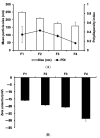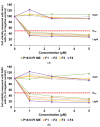Enhanced Photodynamic Therapy Efficacy through Solid Lipid Nanoparticle of Purpurin-18-N-Propylimide Methyl Ester for Cancer Treatment
- PMID: 39408712
- PMCID: PMC11477127
- DOI: 10.3390/ijms251910382
Enhanced Photodynamic Therapy Efficacy through Solid Lipid Nanoparticle of Purpurin-18-N-Propylimide Methyl Ester for Cancer Treatment
Abstract
Photodynamic therapy (PDT) is an innovative cancer treatment that utilizes light. When light irradiates, purpurin-18-N-propylimide methyl ester (P18 N PI ME) generates reactive oxygen species that destroy cancer cells. The hydrophobic nature of P18 N PI ME presents challenges regarding its aggregation in the body, which can affect its effectiveness. This study aimed to enhance the bioavailability and effectiveness of cancer treatment by synthesizing P18 N PI ME and formulating P18 N PI ME-loaded solid lipid nanoparticles (SLNs). The efficacy of PDT was estimated using the 1,3-diphenylisobenzofuran (DPBF) assay and photocytotoxicity tests on the HeLa (human cervical carcinoma) and A549 (human lung carcinoma) cell lines. The P18 N PI ME-loaded SLNs demonstrated particle sizes in the range of 158.59 nm to 248.43 nm and zeta potentials in the range of -15.97 mV to -28.73 mV. These SLNs exhibited sustained release of P18 N PI ME. DPBF analysis revealed enhanced PDT effects with SLNs containing P18 N PI ME compared with standalone P18 N PI MEs. Photocytotoxicity assays indicated toxicity under light irradiation but no toxicity in the dark. Furthermore, the smallest-sized formulation exhibited the most effective photodynamic activity. These findings indicate the potential of P18 N PI ME-loaded SLNs as promising strategies for PDT in cancer therapy.
Keywords: photodynamic therapy; photosensitizers; purpurin-18-N-propylimide methyl ester; solid lipid nanoparticle.
Conflict of interest statement
The authors declare no conflicts of interest.
Figures








References
-
- Abbas Z., Rehman S. An overview of cancer treatment modalities. Neoplasm. 2018;1:139–157.
MeSH terms
Substances
Grants and funding
LinkOut - more resources
Full Text Sources
Research Materials
Miscellaneous

